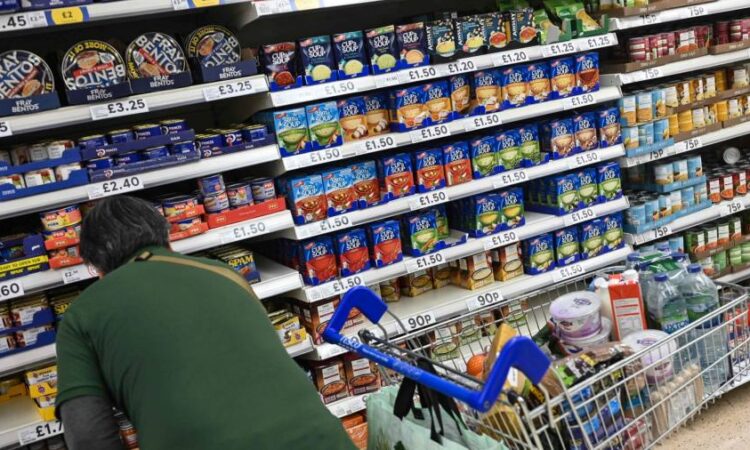
Receive free UK inflation updates
We’ll send you a myFT Daily Digest email rounding up the latest UK inflation news every morning.
Lower gas and electricity costs drove a sharp drop in headline UK inflation in July but underlying price pressures failed to fall as expected, maintaining pressure on the Bank of England to keep interest rates high.
Consumer prices were 6.8 per cent higher in July than a year earlier, falling from an annual increase of 7.9 per cent in June, according to data published on Wednesday by the Office for National Statistics. This drop resulted in the lowest inflation rate since February last year.
The headline figure met economists’ expectations and will come as modest relief after wage data on Tuesday was surprisingly strong. But the details suggested Britain had not made progress in solving its inflation problem.
Stripping out food and energy prices, core inflation rose at an unchanged annual rate of 6.9 per cent in July and services prices increased at a faster pace, maintaining pressure on the BoE to keep monetary policy tight in order to restore price stability.
The central bank’s Monetary Policy Committee this month raised interest rates by 0.25 percentage points to a 15-year high of 5.25 per cent. Markets expect a 15th consecutive increase when the nine-member panel meets in September.
Suren Thiru, economics director at the ICAEW accountancy trade body, said: “Although these figures provide reassurance that the inflation tide has turned, this latest drop owes more to lower energy bills, following the reduction in Ofgem’s energy price cap, than to a broader easing of price pressures.”
The lower quarterly energy price cap led to a 15 per cent fall in gas and electricity prices in July, which contributed to an overall 0.4 per cent drop in prices compared with June.
Food prices stabilised in July, rising only 0.1 per cent in the month and bringing the annual rate of food price inflation down from 17.3 per cent to 14.9 per cent.
Market reaction to the data was muted. Sterling edged higher to $1.274 against the dollar, with the yields on gilts barely moving. With little movement in the bond markets, the figures are unlikely to move mortgage rates.
But the improvements in energy and food prices were offset by signs that there was no moderation in pricing pressures in most other areas.

Prices of core goods rose 0.3 per cent over the month, with the annual inflation rate remaining constant at 6.9 per cent rather than dropping to 6.8 per cent, as economists expected.
Worse news for the BoE was that services prices, which officials see as the best indicator of underlying domestic inflation, rose 0.8 per cent in July. The annual rate of services inflation increased from 7.2 per cent in June to 7.4 per cent in July, the highest rate since March 1992.
Economists said this would worry policymakers because it showed the fast pace of price rises was a more entrenched domestic problem, rather than the unavoidable consequence of higher wholesale gas and electricity costs.
Paula Bejarano Carbo, associate economist at the National Institute of Economic and Social Research, said: “We have yet to see a turning point in the underlying rate of inflation, which remains stagnant at around 7 per cent.”
Ruth Gregory, deputy chief UK economist at the consultancy Capital Economics, said: “With wage growth and services inflation both stronger than the bank had expected, it seems clear that the bank has more work to do.”
Although the underlying data showed worse inflationary pressures than hoped, chancellor Jeremy Hunt hailed the fall in the headline figure of 6.8 per cent as a mark of progress towards the government’s pledge to halve the inflation rate this year.
But he noted there was more work to do. “We’re not at the finish line. We must stick to our plan to halve inflation this year and get it back to the 2 per cent target as soon as possible,” he said in a statement.
Some economists cast doubt on the likelihood of Rishi Sunak meeting his promise on prices, which would require the inflation rate in the fourth quarter of 2023 to fall at least to 5.3 per cent.
The Institute for Fiscal Studies, a think-tank, said it was far from a foregone conclusion that the prime minister would meet his target because most of the known improvements in energy and food costs had happened and progress was yet to be made in moderating price rises elsewhere.
Heidi Karjalainen, IFS research economist, said: “The progress that has been made is mainly due to the fact that commodity and energy prices are no longer increasing at the rates they were last year. The challenge is that core inflation remains stubbornly high, and considerably higher than was expected back at the start of the year.”
Sunak welcomed the drop in inflation as a sign the government’s “plan is working”. He told ITV that pay rises must be “sustainable” and “focused on rewarding productivity increases” after data on Tuesday showed record UK annual wage growth of 7.8 per cent in the three months to June.
The prime minister also acknowledged the state pension could rise by around this amount next year, as he restated his commitment to the triple lock, which holds that the state pension is uprated in April by the highest of three metrics: earnings growth, inflation or 2.5 per cent.
It was “right to step in and help people with the pressures that it [inflation] brings”, he said.






